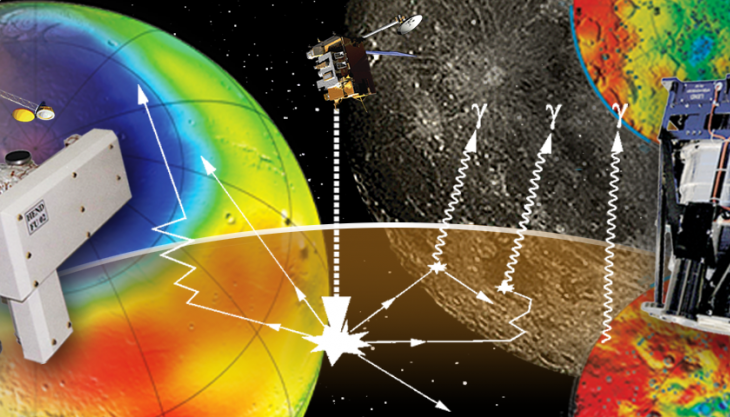Nuclear Planetology

Head of the department
Dr.Sc. Prof.
Igor G. MITROFANOV
Labs
- Neutron and Gamma-ray Spectroscopy. Head: corresponding member of the Russian Academy of Sciences, Professor of the Russian Academy of Sciences Maxim L. LITVAK
- Instruments for Nuclear Physics. Head: Ph.D. Maxim I. MOKROUSOV
- Studies of the Elemental Composition of the Planetary Surfaces. Head: Dr.Sc. Igor G. MITROFANOV
Новости
Head of the department
Dr.Sc. Prof.
Igor G. MITROFANOV
Labs
- Neutron and Gamma-ray Spectroscopy. Head: corresponding member of the Russian Academy of Sciences, Professor of the Russian Academy of Sciences Maxim L. LITVAK
- Instruments for Nuclear Physics. Head: Ph.D. Maxim I. MOKROUSOV
- Studies of the Elemental Composition of the Planetary Surfaces. Head: Dr.Sc. Igor G. MITROFANOV
Themes
- gamma-ray bursts and hard radiation of solar flares;
- nuclear planetology;
- R&D of scientific instruments for space studies;
- Luna-25 and Luna-27 management.
In general
The Nuclear Planetology Department was established on March 3, 2014 on the basis of an independent laboratory of space gamma-ray spectroscopy, which was in its turn formed in August 1992 from a separate scientific group led by Dr. Igor G. Mitrofanov. Even earlier, this group was formed in 1984 by Joseph S. Shklovsky (1916-1985), corresponding member of the USSR Academy of Sciences, then the head of the Department of Extra-atmospheric Astronomy.
The Shklovsky’s Department then united over a dozen laboratories, whose thematic covered almost all spectral ranges of electromagnetic radiation, from radio waves to X-ray and gamma radiation. The Department also had a theoretical astrophysics sector, the staff members successfully had been working on the issues of cosmology, gravity and particle physics.
The nature of the «extra-atmospheric» research of the Shklovsky’s Department required space-borne scientific experiments. The competition for the onboard place was high at that time, the priority in the 1970-1980s being given to Venus and Mars research. At the same time, cosmic gamma-ray bursts became the “hot topic” of astrophysics, especially when cyclotron and annihilation lines were discovered it their spectra by the group of Leningrad astrophysicist Evgeny P. Mazets.
Thus, when the senior researcher of the Department Igor Mitrofanov turned to Joseph Shklovsky with a proposal of an experiment on GRB spectroscopy (to verify the results of Mazets), an inventive Doctor (as the students called Shklovsky) persuaded Prof. Academician Roald Sagdeev, IKI’s director at that time, to enhance the GS-14 instrument already on board the Phobos-1 and Phobos-2 spacecraft. GS-14 experiment’s PI was Prof. Yuri A. Surkov from Vernadsky Institute for Geochemistry and Analytical Chemistry of the USSR Academy of Sciences. So, it was decided that a small VGS block (short for Russian “burst gamma ray spectrometer”) for simultaneous GRB studies would be added to GS-14, which was designed to measure Mars’s gamma-ray emission. Since Igor Mitrofanov was a theoretical physicist and had had no previous experience in instrument design, the VGS unit was built by French colleagues, traditional partners of IKI.
It soon became clear that the VGS could also be used to register Martian gamma rays during a flyby near the Red Planet in order to increase the spatial resolution when measuring gamma rays from Martian surface. So, in 1984, the Mitrofanov group, working in the fields of cosmic gamma-ray spectroscopy and nuclear planetology, appeared in IKI. Five years later, in February 1989, this group, being a part of the Soviet-French team of the APEX (Astrophysical Planetological EXperiment), for the first time registered and investigated with GS-14 and VGS the Mars’s own gamma radiation.
Today, the Department runs six space experiments: in low-Earth orbit (BTN-Neutron, the Russian segment of the ISS), in lunar orbit (LEND/ LRO, NASA), in Mars’ orbit (HEND/Mars Odyssey, NASA; FREND, ExoMars-2016, ESA/Roscosmos) and on the surface of Mars (DAN/Curiosity, NASA). One more experiment is currently on the way to Mercury, that is MGNS/BepiColombo, ESA.
The main results are related to the exploration of the Mars and Moon surfaces and the search for water in the upper layer of their surface. A significant part of water in the upper layer of the Martian surface at equatorial and temperate latitudes and vast areas of permafrost above 60° north and south latitudes were discovered in the early 2000s with the HEND instrument. These results give a basis for the modern ideas about the natural conditions on Mars and its evolution in the past.
The continuous measurements of the neutron radiation of Mars for 9 Martian years provided from orbit by the HEND instrument allowed to create profiles of winter condensation of atmospheric carbon dioxide for the southern and northern hemispheres of the planet and to revise the model of annual seasonal changes on the planet. Since 2016, the joint work of HEND and FRIEND instruments began that helped to discover local areas with very high water content, which are probably «oases» of Martian permafrost.
The LEND neutron telescope, sent to the Moon in 2009, detected areas with an increased hydrogen content in the shallow subsurface. The active LCROSS experiment (NASA) confirmed the fact that it is water ice. Today, thanks to LEND data maps of the distribution of water ice in the lunar shallow subsurface were made, which are used to select the landing areas for future lunar missions.
An active experiment DAN on the surface of Mars allows evaluating the water and chlorine content in the subsurface layer along the Curiosity rover's path inside the Gale crater. This experiment will be followed by ADRON experiment onboard Rosalind Franklin rover (ExoMars-2022, ESA/Roscosmos).
Besides that, the Department’s instruments almost constantly monitor the neutron fluxes in the different parts of the Solar System and serve as a part of InterPlanetary Network (IPN) to register GRBs. HEND and, since 2021, MGNS are two IPN “members”, helping to locate these events and study their properties.
